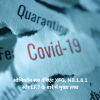.jpg)
 IJCP Editorial Team
IJCP Editorial Team
TONSILLECTOMY
The tonsils are lymph nodes in the back of the mouth and the top of the throat. The tonsils are the immune system's first line of defense against pathogens that enter the mouth, making the tonsils particularly vulnerable to infection and inflammation.
Tonsillitis is often caused by common viruses, but bacterial infections may also induce the manifestation. Tonsillitis is common, especially in children, and can happen once in a while or may reoccur multiple times in a short period. However, the tonsil's immune system function declines after puberty, which may account for the rare cases of tonsillitis in adults.
Tonsillectomy Surgery
Tonsillectomy is the surgical removal of the tonsils, generally used to treat infection and inflammation of the tonsils, and often recommended for recurring and chronic tonsillitis. A tonsillectomy may also be necessary to treat sleep-disordered breathing and other breathing problems, complications of enlarged tonsils, bleeding of the tonsils, and other rare diseases of the tonsils. Tonsil surgery is generally advised if tonsillitis occurs more than seven times in one year, more than four or five times a year for the past two years, or more than three times a year for the past three years.
Before the procedure – Complete information regarding the health and clinical conditions of the patients are gathered using a pre-surgery checklist of questions which include:
Daily medicinal regimen, including over-the-counter drugs and dietary supplements.
Personal or family history of adverse reactions to anesthetics.
Personal or family history of bleeding disorders.
Allergy or other adverse reactions to medications, such as antibiotics.
Instructions related to the procedure include:
The doctor may recommend certain modifications in medications or dosages for several days before the surgery.
Certain foods and specific meal plans might be recommended or prohibited.
Clinical tests and blood analysis are carried out before surgery.
The doctor may also order a sleep study (polysomnography) if a tonsillectomy is intended for treating obstructive sleep apnea, breathing disorders, and other conditions.
During the procedure - A tonsillectomy can be performed in many ways. Usually, the surgeon uses a blade (scalpel) or a specialized surgical tool that uses heat or high-energy heat or sound waves to cut out the tonsils, remove or destroy tissues and stop bleeding. The other options to remove enlarged tonsils include lasers, radio waves, ultrasonic energy, or electrocautery. The surgery is performed under general anesthesia and usually takes 20 to 30 minutes. A surgeon will evaluate the health condition and select the best-suited technique for the particular patient.
After the procedure – Common issues after a tonsillectomy include the following:
Moderate to severe pain in the throat for one to two weeks
Pain in the ears, neck, or jaw
Nausea and vomiting for a few days
Mild fever for several days
Bad breath for up to two weeks
Swelling of the tongue or throat
A feeling of something stuck in the throat
Anxiety or sleep disturbances in children
Management and Recovery
Tonsillectomy is an outpatient procedure that does not require a hospital stay. However, an overnight stay is advisable in case of post-surgery complications, if the surgery is done on a young child or if one has a complex medical condition. Recovery time for a tonsillectomy is usually at least ten days to two weeks.
Few post-operative care measures are necessary for speedy and healthy recovery.
Medications. Take the prescribed medications as directed.
Fluids. Drink plenty of fluids after surgery to avoid dehydration and further complications. Water and ice pops are good choices.
Food. Bland and soft foods that are easy to chew and swallow are the best choices immediately after surgery. Foods like ice cream and pudding can be added to the diet. Avoid acidic, spicy, hard, or crunchy foods that may cause pain or bleeding. Avoid dairy products for the first 24 hours.
Rest. Bed rest is a must for several days after surgery, and strenuous activities, like running and bike riding, should be avoided for two weeks after surgery.
Risks and Concerns
Tonsillectomy, like other surgeries, has certain risks:
Reactions to anesthetics. Minor, short-term problems, such as headache, nausea, vomiting, or muscle soreness are the most common port-surgery effects.
Swelling. Swelling in the tongue and soft palate can cause breathing problems, particularly during the first few hours after the procedure.
Bleeding during surgery. In rare cases, severe bleeding occurs during surgery which requires additional treatment and prolonged hospital stay.
Bleeding during healing. Bleeding can occur during the healing process, particularly if the scab from the wound is dislodged too soon.
Infection. Rarely, surgery can lead to infections that require further treatment.
Emergency Care
Watch for the following complications that require prompt medical care:
Bleeding. Specks of dark blood from the nose or in saliva are common, but any bright red blood requires immediate intervention and might need surgery.
Fever. Call the doctor in case of a fever of 102 F (38.9 C) or higher.
Dehydration. Signs of dehydration, such as reduced urination, thirst, weakness, headache, dizziness, or lightheadedness might need medical assistance.
Breathing problems. Snoring or noisy breathing can occur during the first week of recovery but difficulty in breathing needs emergency care.
Uncontrolled pain - The person might feel the pain that may intensify 3 to 4 days after the surgery. This pain is often worse in the morning and may last up to 2 weeks. The doctor may design a medication plan to address the symptom.
Tonsillitis Prevention
The best way to prevent tonsillitis is through good hygiene, including:
Washing your hands often.
Not sharing food, drink, utensils, or personal items like toothbrushes with anyone.
Staying away from someone who has a sore throat or tonsillitis.

IJCP Editorial Team
Comprising seasoned professionals and experts from the medical field, the IJCP editorial team is dedicated to delivering timely and accurate content and thriving to provide attention-grabbing information for the readers. What sets them apart are their diverse expertise, spanning academia, research, and clinical practice, and their dedication to upholding the highest standards of quality and integrity. With a wealth of experience and a commitment to excellence, the IJCP editorial team strives to provide valuable perspectives, the latest trends, and in-depth analyses across various medical domains, all in a way that keeps you interested and engaged.









.png)




Please login to comment on this article